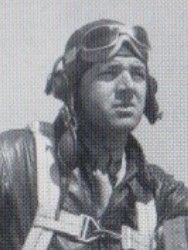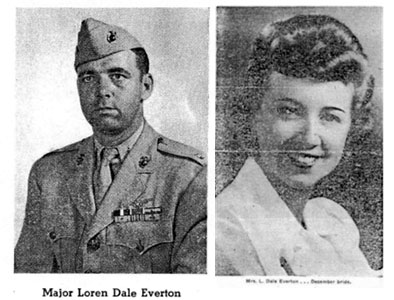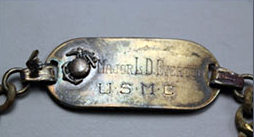Married Dolores Miller 23 December 1942 in Greeley County, Nebraska. She died 15 November 2000 in Santa Ana, California
----------
Graduated from Crofton High School in 1933; from University of Nebraska College of Pharmacy in 1937. Was US Marine Corps fighter pilot for 30 years. Retired from Marine Corps as a Colonel.
-----------
Publication unknown:
LOREN D. EVERTON
A pilot from VMF-212 who saw early service with -223, 'Doc' Everton had been flying for 12 years, since the age of 17. Because of his flying and leadership skills, Col. Bauer sent him with the other seven -212 pilots that went with -223 to Guadalcanal on August 20, 1942. As they came in, Captain Everton was struck by the deceiving beauty of the Island, and how inviting-looking green meadows could really be soggy marshes. The Marines already on the ground welcomed the fliers as saviors. "It looked so damn good to see something American circling in the sky," one of them said. Nonetheless, while Everton was busy with getting his tail wheels changed, from hard carrier types to softer ones better suited to grass strips, someone made off with his food supplies. He was directed to a cocunut grove and to set up his campsite with a captured Japanese tent, blanket, and bedding. The only tent he could find had a roof, but no sides. That night the Battle of Tenaru started, and Doc was up all night with a .45 in one hand and a helmet in the other.
It might have been the next morning when Captain Smith came by holding a map, explaining that the Japs were landing and that Everton was to lead a flight of Wildcats to investigate and "make his own judgement about strafing or returning." They flew out and found the Jap landing craft on the wooded shore. They shot them up with the concentrated firepower of their six .50 caliber machine guns. The effect was wonderful and terrible, as the heavy slugs literally tore the soldiers apart. Everton and his three other planes strafed the men and the boats until the Marine Raiders finished the battle and "there were no more targets available." It was an ideal demonstration of the power of ground and air forces in cooperation.
On August 26, the detached pilots of -212 scored six kills, three of them going to Doc Everton. Everton, Smith, Lt. Corry, and Tex Hamilton intercepted a flight of eighteen Mitsubishi G4M Betty bombers that were returning northward. In Everton's first aerial combat, he was over-anxious and started shooting at the twin-engine Mitsubishi from 400 yards out. But he closed in and began to hit the right engine. Bits of metal flew off. It started to smoke and Everton pulled up and over the bomber, then came at it again. He got within 300 yards, choosing his angle carefully, moving into the Betty's blind spot. The Bettys carried a fixed 26mm machine gun in the tail, which could not be turned from side to side, creating a blind spot on either side. He closed in, aimed at the gas tanks, and the whole side of the plane broke into smoke and flame. It fell out of formation, then dove straight down, as it burst into a shower of flaming junk. No parachutes.
He opened up the throttle and returned to the flight of bombers, now over Malaita. Picking out his target on the right side of the formation, he made a steady firing pass from close range. The plane turned, and Everton countered, firing into the pilot's compartment. This plane too began to smoke, and began a long dive into the sea. As the rest of the Jap bombers continued homeward, fuel and ammo consumption compelled many Wildcats to go back to Henderson Field. But Everton and Smith continued, starting at opposite ends of the row of Bettys. Everton shot up his third victim of the mission, seeing it trail into the ocean. He also hit a fourth in the engine, but this only counted as a probable, as he didn't actually see it crash or explode.
By September 1, Everton and the other -212 pilots who had served with -223 were relieved and went to Efate. He returned to Guadalcanal, on October 16, when Joe Bauer saved the McFarland. Two days later he co-led a mission with Frederick Payne, each leading three planes that intercepted the bombers at about 26,000 feet. Everton rose above the bombers to engage the Zeros above. For some reason the Zeros were doing slow rolls and other aerobatics. Everton got behind one and opened up on it with all six guns. It exploded into smoke and flames. However loud these explosions were, a pilot could only hear his own engine and radio. During combat, the radio was filled with the excited shouts of the pilots and the enthusiastic cheers of the ground personnel. Everton got a second plane that day when he luckily found himself behind and above a Zero. He dove, fired, and sent the Jap down in flames.
On October 20, Bauer at first held Everton in reserve, scrambling him and four others when a large flight of Bettys and Zeros came over. On his first pass, he started a bomber smoking badly, and recorded a probable. Soon fifteen more Zeros appeared, and the ensuing melee defied accurate recollection, except for its end (for Everton). Again he got above and behind a Zero, ready to open up, when another Zero got on HIS tail, hitting him with small caliber machine gun bullets and then shaking the whole plane with 20mm cannon shells. Two of the shells burst in the cockpit, injuring him and knocking his leg off the rudder which sent the Wildcat into a spin. He spun down to about 19,000 feet (hoping to look dead to the Zeros) before pulling out of the dive. He had to lift his injured and numb leg with his hand and place it on the rudder pedal. Heading back to Henderson Field, he radioed that he was coming in for an immediate forced landing.
"You can't land here." he was told.
"The hell I can't!" he replied, and by then he was on the deck.
He described the results later, "The plane was junk when I got it down. They stripped off a few useful parts, but the rest of it just went on the pile. The fragments of shrapnel are very sharp, and they slash through the thin metal of the plane like a razor through paper."
He was evacuated because of his wounds.
Sources:
Max Brand, Fighter Squadron at Guadalcanal, Pocket Books, 1996
Thomas G. Miller, The Cactus Air Force, Harper and Row, 1969
------------
Newspaper unknown, Wednesday, February 20, 1991, p.B6
COL. L.D. EVERTON, ACE FLIER, EL TORO OFFICER, DIES
SANTA ANA -- Col. L.D. (Doc) Everton, commanding officer of the first fighter squadron commissioned at El Toro Marine Corps Air Station, died Friday of cancer at his Santa Ana home. He was 75.
Everton earned dozens of military awards and medals during a 30-year career which began in 1933 when he entered the Army Reserve Officer Training Corps at the University of Nebraska, according to his sons, Todd and Mark Everton.
In 1937, he accepted a commission in the Army Reserve, but resigned from the position two years later to enlist in the Marine Corps to become a pilot, the sons said Tuesday.
Less than a year after finishing flight training, Everton flew in defense of Midway Island when the Japanese attacked on Dec. 7, 1941, they said.
During the World War II, he received the Navy Cross for shooting down 10 enemy planes over Guadalcanal between August and October, 1942, they said. He also earned a Distinguished Flying Cross and was credited eventually with 13 enemy aircraft and one probable, his sons said, adding that Everton earned a Purple Heart fo his combat wounds.
In 1943, Everton was assigned as commanding officer of VMF-113, the first fighter squadron to be commissioned at El Toro.
In addition to his sons, Everton is survived by his wife of 48 years, Dolores; two grandchildren, a brother and two sisters.
Graveside memorial services will be held today at 11 a.m. at El Toro Memorial Park. It is requested that in lieu of flowers, donations be made to the MCAS El Toro Historical Foundation, MCAS El Toro, Santa Ana, 92709.
Married Dolores Miller 23 December 1942 in Greeley County, Nebraska. She died 15 November 2000 in Santa Ana, California
----------
Graduated from Crofton High School in 1933; from University of Nebraska College of Pharmacy in 1937. Was US Marine Corps fighter pilot for 30 years. Retired from Marine Corps as a Colonel.
-----------
Publication unknown:
LOREN D. EVERTON
A pilot from VMF-212 who saw early service with -223, 'Doc' Everton had been flying for 12 years, since the age of 17. Because of his flying and leadership skills, Col. Bauer sent him with the other seven -212 pilots that went with -223 to Guadalcanal on August 20, 1942. As they came in, Captain Everton was struck by the deceiving beauty of the Island, and how inviting-looking green meadows could really be soggy marshes. The Marines already on the ground welcomed the fliers as saviors. "It looked so damn good to see something American circling in the sky," one of them said. Nonetheless, while Everton was busy with getting his tail wheels changed, from hard carrier types to softer ones better suited to grass strips, someone made off with his food supplies. He was directed to a cocunut grove and to set up his campsite with a captured Japanese tent, blanket, and bedding. The only tent he could find had a roof, but no sides. That night the Battle of Tenaru started, and Doc was up all night with a .45 in one hand and a helmet in the other.
It might have been the next morning when Captain Smith came by holding a map, explaining that the Japs were landing and that Everton was to lead a flight of Wildcats to investigate and "make his own judgement about strafing or returning." They flew out and found the Jap landing craft on the wooded shore. They shot them up with the concentrated firepower of their six .50 caliber machine guns. The effect was wonderful and terrible, as the heavy slugs literally tore the soldiers apart. Everton and his three other planes strafed the men and the boats until the Marine Raiders finished the battle and "there were no more targets available." It was an ideal demonstration of the power of ground and air forces in cooperation.
On August 26, the detached pilots of -212 scored six kills, three of them going to Doc Everton. Everton, Smith, Lt. Corry, and Tex Hamilton intercepted a flight of eighteen Mitsubishi G4M Betty bombers that were returning northward. In Everton's first aerial combat, he was over-anxious and started shooting at the twin-engine Mitsubishi from 400 yards out. But he closed in and began to hit the right engine. Bits of metal flew off. It started to smoke and Everton pulled up and over the bomber, then came at it again. He got within 300 yards, choosing his angle carefully, moving into the Betty's blind spot. The Bettys carried a fixed 26mm machine gun in the tail, which could not be turned from side to side, creating a blind spot on either side. He closed in, aimed at the gas tanks, and the whole side of the plane broke into smoke and flame. It fell out of formation, then dove straight down, as it burst into a shower of flaming junk. No parachutes.
He opened up the throttle and returned to the flight of bombers, now over Malaita. Picking out his target on the right side of the formation, he made a steady firing pass from close range. The plane turned, and Everton countered, firing into the pilot's compartment. This plane too began to smoke, and began a long dive into the sea. As the rest of the Jap bombers continued homeward, fuel and ammo consumption compelled many Wildcats to go back to Henderson Field. But Everton and Smith continued, starting at opposite ends of the row of Bettys. Everton shot up his third victim of the mission, seeing it trail into the ocean. He also hit a fourth in the engine, but this only counted as a probable, as he didn't actually see it crash or explode.
By September 1, Everton and the other -212 pilots who had served with -223 were relieved and went to Efate. He returned to Guadalcanal, on October 16, when Joe Bauer saved the McFarland. Two days later he co-led a mission with Frederick Payne, each leading three planes that intercepted the bombers at about 26,000 feet. Everton rose above the bombers to engage the Zeros above. For some reason the Zeros were doing slow rolls and other aerobatics. Everton got behind one and opened up on it with all six guns. It exploded into smoke and flames. However loud these explosions were, a pilot could only hear his own engine and radio. During combat, the radio was filled with the excited shouts of the pilots and the enthusiastic cheers of the ground personnel. Everton got a second plane that day when he luckily found himself behind and above a Zero. He dove, fired, and sent the Jap down in flames.
On October 20, Bauer at first held Everton in reserve, scrambling him and four others when a large flight of Bettys and Zeros came over. On his first pass, he started a bomber smoking badly, and recorded a probable. Soon fifteen more Zeros appeared, and the ensuing melee defied accurate recollection, except for its end (for Everton). Again he got above and behind a Zero, ready to open up, when another Zero got on HIS tail, hitting him with small caliber machine gun bullets and then shaking the whole plane with 20mm cannon shells. Two of the shells burst in the cockpit, injuring him and knocking his leg off the rudder which sent the Wildcat into a spin. He spun down to about 19,000 feet (hoping to look dead to the Zeros) before pulling out of the dive. He had to lift his injured and numb leg with his hand and place it on the rudder pedal. Heading back to Henderson Field, he radioed that he was coming in for an immediate forced landing.
"You can't land here." he was told.
"The hell I can't!" he replied, and by then he was on the deck.
He described the results later, "The plane was junk when I got it down. They stripped off a few useful parts, but the rest of it just went on the pile. The fragments of shrapnel are very sharp, and they slash through the thin metal of the plane like a razor through paper."
He was evacuated because of his wounds.
Sources:
Max Brand, Fighter Squadron at Guadalcanal, Pocket Books, 1996
Thomas G. Miller, The Cactus Air Force, Harper and Row, 1969
------------
Newspaper unknown, Wednesday, February 20, 1991, p.B6
COL. L.D. EVERTON, ACE FLIER, EL TORO OFFICER, DIES
SANTA ANA -- Col. L.D. (Doc) Everton, commanding officer of the first fighter squadron commissioned at El Toro Marine Corps Air Station, died Friday of cancer at his Santa Ana home. He was 75.
Everton earned dozens of military awards and medals during a 30-year career which began in 1933 when he entered the Army Reserve Officer Training Corps at the University of Nebraska, according to his sons, Todd and Mark Everton.
In 1937, he accepted a commission in the Army Reserve, but resigned from the position two years later to enlist in the Marine Corps to become a pilot, the sons said Tuesday.
Less than a year after finishing flight training, Everton flew in defense of Midway Island when the Japanese attacked on Dec. 7, 1941, they said.
During the World War II, he received the Navy Cross for shooting down 10 enemy planes over Guadalcanal between August and October, 1942, they said. He also earned a Distinguished Flying Cross and was credited eventually with 13 enemy aircraft and one probable, his sons said, adding that Everton earned a Purple Heart fo his combat wounds.
In 1943, Everton was assigned as commanding officer of VMF-113, the first fighter squadron to be commissioned at El Toro.
In addition to his sons, Everton is survived by his wife of 48 years, Dolores; two grandchildren, a brother and two sisters.
Graveside memorial services will be held today at 11 a.m. at El Toro Memorial Park. It is requested that in lieu of flowers, donations be made to the MCAS El Toro Historical Foundation, MCAS El Toro, Santa Ana, 92709.
Family Members
Sponsored by Ancestry
Advertisement
Advertisement

















